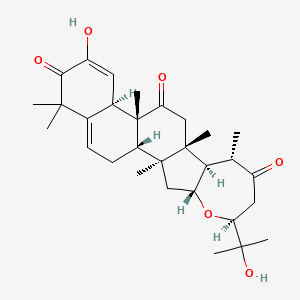| Authors | Title | Published | Journal | PubMed Link |
|---|---|---|---|---|
| Theis N et al. | Attracting mutualists and antagonists: plant trait variation explains the distribution of specialist floral herbivores and pollinators on crops and wild gourds. | 2014 | Am. J. Bot. | pmid:25156980 |
| Chen CH et al. | Identification of cucurbitacins and assembly of a draft genome for Aquilaria agallocha. | 2014 | BMC Genomics | pmid:25005802 |
| Muchtaridi M et al. | Potential activity of fevicordin-A from Phaleria macrocarpa (Scheff) Boerl. seeds as estrogen receptor antagonist based on cytotoxicity and molecular modelling studies. | 2014 | Int J Mol Sci | pmid:24776765 |
| Wang Y et al. | Cucurbitacin IIb exhibits anti-inflammatory activity through modulating multiple cellular behaviors of mouse lymphocytes. | 2014 | PLoS ONE | pmid:24587010 |
| Xu XT et al. | [Study on in vivo pharmacokinetics of cucurbitacin injection in rats]. | 2014 | Zhongguo Zhong Yao Za Zhi | pmid:25272856 |
| Zhang S et al. | Localization of a new gene for bitterness in cucumber. | 2013 Jan-Feb | J. Hered. | pmid:23091223 |
| Lang KL et al. | Chemical modification produces species-specific changes in cucurbitacin antifeedant effect. | 2013 | J. Agric. Food Chem. | pmid:23646892 |
| Zhang YT et al. | Formation of cofilin-actin rods following cucurbitacin-B-induced actin aggregation depends on Slingshot homolog 1-mediated cofilin hyperactivation. | 2013 | J. Cell. Biochem. | pmid:23695982 |
| Guo RH et al. | Synthesis of hemslecin A derivatives: a new class of hepatitis B virus inhibitors. | 2013 | Bioorg. Med. Chem. Lett. | pmid:23385212 |
| He J et al. | Cucurbitacin IIa induces caspase-3-dependent apoptosis and enhances autophagy in lipopolysaccharide-stimulated RAW 264.7 macrophages. | 2013 | Int. Immunopharmacol. | pmid:23541744 |
Cucurbitacin S
Cucurbitacin s is a lipid of Sterol Lipids (ST) class. The involved functions are known as establishment and maintenance of localization and nitric oxide biosynthetic process.
Cross Reference
Introduction
To understand associated biological information of Cucurbitacin S, we collected biological information of abnormalities, associated pathways, cellular/molecular locations, biological functions, related genes/proteins, lipids and common seen animal/experimental models with organized paragraphs from literatures.
What diseases are associated with Cucurbitacin S?
There are no associated biomedical information in the current reference collection.
No disease MeSH terms mapped to the current reference collection.
PubChem Associated disorders and diseases
What pathways are associated with Cucurbitacin S
There are no associated biomedical information in the current reference collection.
PubChem Biomolecular Interactions and Pathways
Link to PubChem Biomolecular Interactions and PathwaysWhat cellular locations are associated with Cucurbitacin S?
There are no associated biomedical information in the current reference collection.
What functions are associated with Cucurbitacin S?
Related references are published most in these journals:
| Function | Cross reference | Weighted score | Related literatures |
|---|
What lipids are associated with Cucurbitacin S?
There are no associated biomedical information in the current reference collection.
What genes are associated with Cucurbitacin S?
There are no associated biomedical information in the current reference collection.
What common seen animal models are associated with Cucurbitacin S?
There are no associated biomedical information in the current reference collection.
